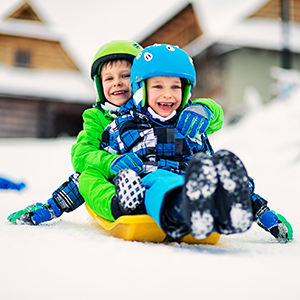Winter Safety Tips for Kids

Winter is here! And with the snow also comes sledding, skiing, ice skating, and other cold-weather fun. These activities are always a joy, but can lead to some big injuries, too.
Each year U.S. healthcare facilities treat more than 20,000 snowmobile-related injuries, more than 23,000 from sledding and tobogganing, and 43,000+ from ice skating.
It seems like winter is at least half the year here in northern Michigan. And kids need their snowy fun. With a little planning, you can help your kids enjoy their favorite winter activities while keeping injuries to a minimum.
Four winter safety tips to remember
According to Tammie Budrow, founder of the Chill Out for Winter Safety program, these four tips are easy to remember and will resonate with kids:
- Always dress for the weather
- Use proper gear and a helmet when doing something fast
- Take a buddy with you
- Always ask permission from an adult
“Many winter injuries could be avoided If everyone, young and old, followed these four safety tips,” said Budrow, who is also Department Coordinator, Munson Healthcare Provider Relations & Continuing Medical Education.
“Adults don’t need to ask permission but should absolutely let someone know where they’re going to be. You'll not only protect yourself but will also set a great example for your kids. Have fun this winter, but please Chill Out and play safe!”
Chill Out for Winter Safety was created to both raise awareness of preventable injuries and to keep northern Michigan families safe. Munson Healthcare supports this award-winning program, which is shared with hundreds of children and parents throughout northern Michigan each year.
Preventing sport-specific winter injuries
Here are some additional tips for having fun and staying safe while enjoying a variety of winter activities:
Sledding Safety
-

- Have them sit facing forward, feet first. They should not lay down on the sled.
- Find a hill or a sledding course with no trees or other obstacles.
- Sleds with runners and steering mechanisms are safer than disks or tubes.
- Teach your kids to roll off a sled that won’t stop or they can’t control.
- Avoid sledding hills near roads or parking lots with lots of traffic.
- Supervise children when sledding as much as possible.
Skating and Ice Hockey Safety
- Kids should always wear helmets and appropriate protective gear when playing hockey or skating.
- Make sure their skates and gear fit properly and provide good ankle support.
- Kids should only skate when and where ice has been checked for safety. Always look for cracks, holes, or debris.
- Children should understand basic skating skills such as how to stop and fall properly.
- Make sure your kids know to never skate alone. Always take a buddy.
Ice Safety
- Adults always should supervise children on frozen lakes and ponds. Only venture onto ice that has been approved by an adult. Check out this article from MSU Extension for tips on determining if ice is safe.
- Ice on moving waters (rivers, streams) is never safe.
- Learn more about ice safety.
Skiing and Snowboarding Safety
-

- Make sure they wear a properly fitted helmet designed for skiing or snowboarding. And always check to make sure helmets and other equipment are in good condition.
- Kids should never ski or snowboard alone. They should always take a buddy.
- Make sure they dress in layers to maintain warmth.
Snowmobiling Safety
- Children should be supervised by an adult. If kids are between 12-17 years old, they must have a Snowmobile Safety Certificate.
- Always wear a helmet, goggles, and gloves.
- Slow down – high speed almost always factors into fatalities.
- Make sure your machine is in good condition before hitting the trails.
- Avoid crossing frozen lakes, ponds, and rivers whenever possible.
Winter Car Seat Safety

“Instead of bulky clothing, parents should dress their littles in thin layers and warm up the car before buckling their child in the car seat,” Vandegrift said. “Once they're strapped in, place a warm blanket over the child's legs to help them stay toasty warm throughout the trip.”
Have fun, and always wear a helmet
Whether they’re skiing, snowboarding, sledding, or skating, learning basic skills and using the appropriate safety gear will minimize your child’s risk for injury.
And try and remember kids should not overdo it. Take a break or call it a day when you notice your child is tired. Anyone pushing themselves when tired can increase the risk of harm to themselves and to others.
Be sure to seek shelter and medical attention if your child or anyone nearby shows signs of frostbite (numbness and skin that is waxy or yellow, gray, or blue in color) or hypothermia (shivering, exhaustion, confusion, and slurred speech). And always dial 9-1-1 immediately during a medical emergency.